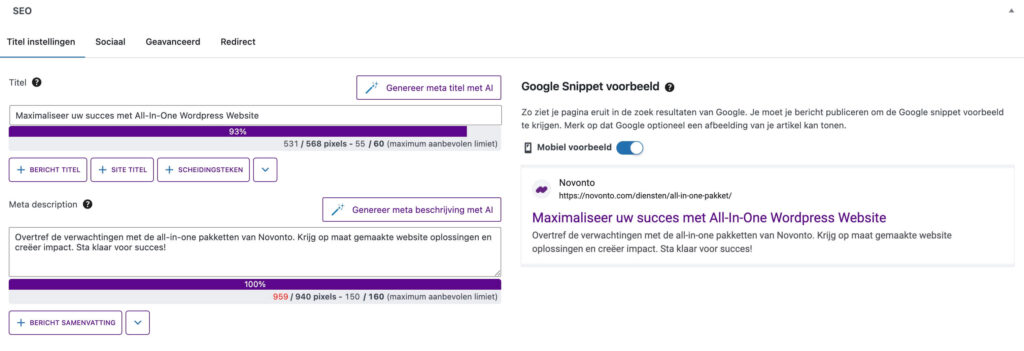Creating a website that ranks well in Google is not easy, especially if you are new to this field. The team at Novonto has a lot of experience building websites on platforms like WordPress, but even we have made mistakes in the past and learned from them.
If you’re just starting to create your very first website, it’s understandable that you can get overwhelmed. There’s a lot involved in optimizing your website for search engines, also known as SEO (Search Engine Optimization). But don’t worry, we’re here to help.
SEO is basically about making sure your website can be easily found by people looking for the information, products or services you offer. It’s like having a digital business card that you want to show potential customers when they search online.
In this article, we share the common mistakes you want to avoid when creating your first website. We want your website to stand out among the many others on the Internet, and for that, it is important to avoid these mistakes.
We understand that SEO may be new to you, so let’s keep it simple. We’ll give you practical tips and methods in the following sections to get around these pitfalls and make sure your SEO doesn’t go haywire. Even if you’ve never heard of SEO, after reading this article you’ll have a better understanding of why it’s so important for your website.
Not knowing why you are building a site
Building a Web site without a clear understanding of why you are doing it can be a frustrating experience for everyone involved! You are unlikely to be satisfied with the end result and you will probably have to start over. This is why it is crucial to have a clear goal in mind.
Why are you building this website in the first place? Is it to make your brand better known to a wider audience? Maybe you want to generate traffic to make money through advertising or you want to collect leads for your services. Maybe you even sell products and want to set up an online store.
If one of your goals is to receive traffic from Google, then “be found in Google” be one of your main objectives. This means that SEO should be integrated into your project from the beginning. But what exactly is SEO? In a nutshell, it’s about making sure your website is easy to find for people searching online for what you offer.
To achieve this, you need to think about the words and phrases that people are likely to type into Google when they are looking for your products, services or information. These are the search terms for which you want your Web site to appear in search results.
So, before you start building your Web site, make a list of the search terms that are important to your business. These can be general terms that describe your business, as well as specific words related to the products or services you offer. These search terms will form the basis of your SEO strategy and will help you create the right content for your website. This will ensure that your website is relevant to the people searching for it, which will ultimately lead to more traffic and better results for your business.
Choosing the wrong CMS
Choosing the wrong CMS (Content Management System) can have a big impact on the effectiveness of your website, especially when it comes to SEO. A CMS is the software you use to manage your website, add pages, edit content and much more.
If you choose the wrong CMS, you run the risk of using a platform that is difficult to understand or does not provide the necessary functionality to optimize your website for search engines. This means you may not be able to make all the necessary changes to optimize each page and image for better search results.
Imagine you’d like to implement certain search terms on every page, but the CMS you’re using doesn’t allow it or makes it complicated. This can result in a situation where you cannot perform all the search engine optimizations necessary to rank above your competitors in Google.
Another scenario is when you decide to add a new feature to your website, such as a shopping cart for e-commerce, and you discover that the current CMS does not easily or cost-effectively support this feature.
To avoid these problems, it is essential to choose the right CMS that suits your needs and goals. In a later chapter, we will go into more detail about choosing the best CMS for your specific situation, so that you have a solid foundation for an effective and high-performing website. This will help you work more easily and efficiently on your website’s SEO and achieve your goals.
No consideration of SEO during design
It is crucial to keep SEO (Search Engine Optimization) in mind while designing your website. Why? Because the design of your site directly affects how well it performs in search engines such as Google.
When you don’t consider SEO during design, you run the risk that choices for your website’s visual identity will take precedence over decisions that are critical to SEO, such as navigation and page layout. It is not uncommon for website designers or themes you use to have ignored or not given proper consideration to SEO aspects while creating the design.
This can lead to a website that looks great but struggles to rank well in search engines because of technical problems or improper structure. To avoid this, it is important to incorporate SEO requirements, including key search terms, from the very beginning of your website project.
For example, consider using search terms in titles, headlines and meta descriptions. Make sure your site’s navigation is logically structured, with clear categories and tags that help search engines understand what your pages are about. The speed of your website, mobile friendliness, HTML formatting and usability are also important factors for SEO.
In the section on SEO strategy below, we will share some key best practices to ensure your website is properly optimized for search engines. It is an investment in the future visibility and success of your website, so it definitely pays to pay attention to this early in the process.
Choosing the wrong domain name
Choosing the wrong domain name when creating your first website can be challenging for ranking in Google. It is essential to make the right considerations here. This can range from inadvertently targeting another country with an inappropriate top-level domain name (examples: .nl /.com /.eu) to selecting a domain name that is too similar to that of another website.
Changing a domain name after your Web site is already active presents significant challenges. Not only do you have to change the address of every page and image on your Web site, but you also have to contact other Web sites to have their links changed to the new address. This process can be time-consuming and can even lead to loss of traffic and SEO value you have already built up.
So it is very important to choose the right domain name right away when creating your website. This will prevent later problems and ensure a smooth start.
Not writing enough original content
Not writing enough original content for a new website can have an impact on how Google rates your site. It is crucial to provide unique and valuable content that attracts users and helps them find what they are looking for.
When Google ignores a site, it means the site is not indexed and therefore does not appear in search results. Even if your site does get indexed, it can still be difficult to appear high in search results. This may have to do with how Google assesses the relevance and value of your content to users.
Copying text already published elsewhere on the Web can be seen as lacking original content or even attempting to trick Google by duplicating content. Neither situation contributes to improving your ranking in search results.
Therefore, we recommend writing at least 300 words of unique content for each page on which you want Google to rank your website. However, for many search terms and competitive techniques, it is often necessary to provide even more extensive and unique content to rank higher than the websites already in the top 10 positions.
It’s all about providing value to your visitors and providing them with information they can’t find anywhere else. This way, you not only increase your chances of ranking higher in search engines, but also create a better user experience for your visitors, which ultimately leads to more traffic and better results for your website.
Ignoring TITLE and Meta Description tags
Ignoring TITLE and Meta Description tags, also known as SEO tags, can be a missed opportunity for optimizing your Web site for search engines. These tags play an important role in how your pages are displayed in search results and can increase Google’s traffic to your site.
It’s surprising how often these elements are overlooked. Not using these tags means you are not only missing the opportunity to add your targeted keywords to your pages, but also the chance to provide an engaging introduction that encourages users to click through.

One reason these tags are sometimes ignored on new Web sites is because they are not directly visible on the page itself. Some Content Management Systems (CMS) make it difficult to edit them or don’t display them in an easily accessible way. The contents of a TITLE tag are visible in your browser’s tab, but to view META tags, you must inspect the page’s source code.
However, it is very important to use these tags and optimize them carefully. The TITLE tag displays the title of your page in search results and should be relevant to the content of the page and contain what you want to be found on. The Meta Description tag provides a brief summary of the content of the page and should be attractive enough to entice users to click on your link.
By setting these tags correctly, you not only increase the likelihood that your pages will rank better in search engines, but also that users will be encouraged to click through to your site. So it’s a small but crucial step in improving your website’s traffic and visibility. At Novonto, you get a premium SEO tool to take care of all the above easily when you create a new page.
Not using Google Search Console
Not using Google Search Console can be a missed opportunity to optimize your Web site’s performance. This free tool from Google allows you to identify yourself as the website owner, giving you access to valuable performance and indexing reports from Google.
One of the main benefits of Google Search Console is that it gives Google a way to contact you if problems are discovered on your site, such as if your site has been hacked. This allows you to take quick action and fix any problems before they have serious consequences for your site and your search engine ranking.
Not creating a Google Search Console account as soon as you launch your site can lead to significant delays in Google indexing your pages. It’s like missing an important signal to Google that your new website is there and ready to be indexed.
In addition, Google Search Console provides valuable insights and information that can help improve your site for both visitors and Google itself. For example, you get insights into which searches your website is displaying in search results, which pages are getting the most clicks, whether there are any errors crawling your site, and much more.
By using Google Search Console you not only take advantage of the opportunity to quickly identify and solve problems, but also to optimize your website for better performance and visibility in search engines. It is therefore highly recommended that you create a Google Search Console account immediately after launching your website and make regular use of the information and tools available. This will lay a solid foundation for the success of your website on the web.
Not seeking natural backlinks
Not actively seeking natural backlinks for a new Web site can have a significant impact on Google’s ranking. Backlinks, links from other Web sites to your site, are an essential part of Google’s ranking system. They help Google assess the popularity and authority of your Web site.
A lack of backlinks means that your Web site will have a harder time ranking high in search results. It’s as if your website is not getting recognition from other sources on the Internet.
Fortunately, there are numerous ways to obtain natural backlinks. These can include creating high-quality and relevant content that others want to share and link to, actively participating in the online community and relevant websites, guest blogging on other sites, sharing your expertise through interviews or podcasts, and building relationships with others in your industry.
For a successful long-term SEO strategy, it is very important to work on obtaining and maintaining natural backlinks. This will not only increase the visibility and authority of your website, but also help strengthen your position in Google’s search results. So it is an important part of building and growing a strong online presence for your website.
SEO is not a one-time task
Thinking of SEO as a one-time task can be a pitfall for people building their first Web site. It is a fallacy to think that once the Web site is published, the job is done. In reality, a Web site is a dynamic publication that can be constantly improved and expanded. Therefore, it is better to view the publication date of your first Web site as the starting point and not the end point.
For SEO, it is crucial to understand that you can gain significant advantage in Google’s search results by regularly adding new content to your site and optimizing your pages over time. Search engines value websites that are actively updated and provide valuable, relevant information to users.
Getting good search engine rankings is an ongoing process. This means focusing not only on creating a beautiful website at launch, but also on maintaining and improving your site in the future. This includes regularly checking and updating your content, adding new pages and features, and building natural backlinks from other relevant and reliable websites.
Now that you are familiar with what to avoid, the following chapters will cover the methods you can use to make the right choices when building your first Web site:
- Preparing an SEO strategy for a new site
- Choosing the right domain name
- Selecting the best CMS for your project and SEO strategy
- The SEO tasks you should perform immediately after launching a new site
By viewing SEO as a long-term investment and constantly working to optimize your website, you increase your chances of success and better results in Google’s search results. It is an ongoing effort that will boost your website’s long-term growth and visibility.en.






